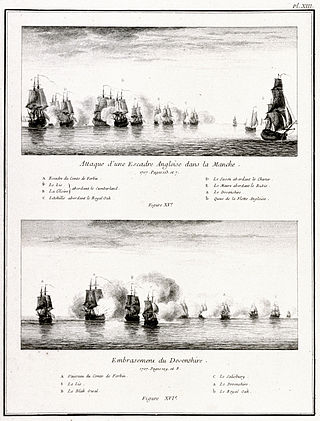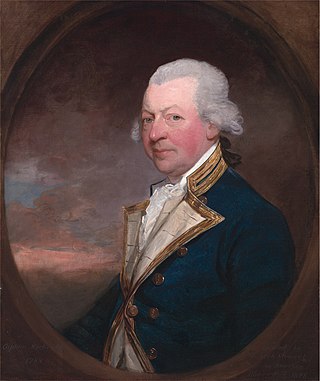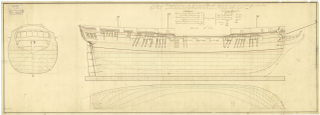
HMS Hannibal was a 74-gun third-rate ship of the line of the Royal Navy, launched on 15 April 1786, named after the Carthaginian general Hannibal. She is best known for having taken part in the Algeciras Campaign, and for having run aground during the First Battle of Algeciras on 5 July 1801, which resulted in her capture. She then served in the French Navy until she was broken up in 1824.
HMS Unicorn was a 28-gun Lyme-class sixth-rate frigate of the Royal Navy. She was originally ordered as a 24-gun ship to the draft of the French privateer Tyger. The third vessel of the Royal Navy to bear the name, Unicorn, as well as HMS Lyme which was a near-sister, were the first true frigates built for the Royal Navy. They were actually completed with 28 guns including the four smaller weapons on the quarterdeck, but the latter were not included in the ship's official establishment until 22 September 1756. The two ships differed in detail, Unicorn having a beakhead bow, a unicorn figurehead, two-light quarter galleries, and only five pairs of quarterdeck gunports, while Lyme had a round bow, a lion figurehead, three-light quarter galleries, and six pairs of quarterdeck gunports.

HMS Cambridge was an 80-gun third-rate ship of the line of the Royal Navy, designed by Sir Joseph Allin and built at Deptford Dockyard by Adam Hayes to the draught specified by the 1745 Establishment as amended in 1750, and launched on 21 October 1755.
Jonathan Faulknor was an officer of the Royal Navy who served during the Seven Years' War, the American War of Independence, and the French Revolutionary Wars, in a career which spanned fifty years.

Vestale was a Blonde-class 30-gun frigate of the French Navy. The Royal Navy captured her in 1761, but had to scuttle her in 1778 to avoid having the French recapture her. She was refloated and sold to the French in 1784. She returned to wartime service in 1794 as a privateer. The British recaptured her in 1798 and broke her up thereafter.

HMS Salisbury was a 50-gun fourth rate ship of the line of the Royal Navy, built by Richard and James Herring at Baileys Hard on the Beaulieu River in Hampshire, England, and launched on 18 April 1698.

HMS Expedition was a 70-gun third-rate ship of the line built at Portsmouth Dockyard in 1677/79. She was in active commission during the War of the English Succession participating in the battles of Beachy Head and Barfleur. She was rebuilt in 1699. Again, for the War of Spanish Succession she was in commission for the operation at Cadiz then returned to England where she sat for two years. She was in the Mediterranean for the Battle of Marbella in 1705. She then went to the West Indies and fought in Wager's action off Cartagena in 1708. She was rebuilt in 1709-14 to the 1706 Establishment. She spent her time split between the Baltic and as guard ship at Portsmouth before being broken at Portsmouth in 1736. She was rebuilt in 1736/40 at Deptford Dockyard.

HMS Tiger or Tygre was a 60-gun fourth rate ship of the line of the Royal Navy, built at Rotherhithe to the draught specified by the 1745 Establishment and launched on 23 November 1747.

HMS York was a 60-gun fourth rate ship of the line of the Royal Navy, built at Plymouth Dockyard to the draught specified in the 1745 Establishment, and launched on 10 November 1753. She saw active service during the Seven Years' War against France, and was responsible for the capture of seven French vessels over her ten years at sea. After extensive service in Europe, North America and the east Indies, York was decommissioned in 1765 and broken up at Plymouth in 1772.
Barrington Dacres was an officer of the Royal Navy, who saw service during the French Revolutionary and Napoleonic Wars. He eventually rose to the rank of Post-Captain. He did not see action in many significant engagements, and is chiefly remembered for the accidental loss of his ship to the French, and for the unsuccessful chase of two French ships in the English Channel. He did command a number of ships of the line under several of the leading naval commanders of his time. His early death, however, prevented him from achieving the same seniority and degree of fame as his relatives did.
HMS Boreas was a 28-gun Coventry-class sixth-rate frigate of the Royal Navy. Built by Israel Pownoll at Woolwich Dockyard and launched in 1757, she was one of five frigates of the class built of fir rather than oak. Boreas saw service during the Seven Years' War and took part in two actions at sea. She assisted in the capture of the 36-gun French frigate Diane in April 1758, and her most famous engagement was the capture of the French frigate Sirène in October 1760. She was sold out of the service in 1770.

HMS Vengeance was originally the 48-gun French Navy frigate Vengeance and lead ship of her class. She engaged USS Constellation during the Quasi-War, in an inconclusive engagement that left both ships heavily damaged. During the French Revolutionary Wars, HMS Seine hunted Vengeance down and captured her after a sharp action. She was recommissioned in the Royal Navy as the 38-gun fifth rate HMS Vengeance, but the British apparently never returned her to seagoing service. Accounts are divided as to her eventual fate. She may have been broken up in 1803 after grounding in 1801, or continued as a prison ship until 1814.
Admiral Sir Lawrence William Halsted GCB was an officer of the Royal Navy who served during the American War of Independence and the French Revolutionary and Napoleonic Wars.

John MacBride was a British officer of the Royal Navy and a politician who saw service during the Seven Years' War, the American War of Independence and the French Revolutionary Wars, eventually rising to the rank of Admiral of the Blue.

HMS Montreal was a 32-gun Niger-class fifth-rate frigate of the Royal Navy. She was launched in 1761 and served in the Seven Years' War and the American War of Independence. The French captured her in 1779 and she then served with them under the name Montréal. An Anglo-Spanish force destroyed her during the occupation of Toulon early in the French Revolutionary Wars.
Charles Inglis was an officer of the Royal Navy who saw service during the French Revolutionary and Napoleonic Wars, rising to the rank of post-captain.

HMS Pallas was one of the three 36-gun Venus-class fifth-rate frigates of the Royal Navy. She was launched in 1757 and initially served in Sir Edward Hawke's fleet blockading the coast of France where she fought at the Raid on Cherbourg and in the Battle of Bishops Court. She later served for a number of years in the Mediterranean Sea before moving to serve off the coast of Africa between 1774 and 1776 where she protected the isolated British colonies. In 1778 she joined the Newfoundland Station and participated in the attack on Saint Pierre and Miquelon. Pallas returned to the English Channel after this and assisted in destroying a French invasion force intended for the Channel Islands in 1779 before briefly serving on the Jamaica Station. In 1783 she was beached on São Jorge Island after she was found to be heavily leaking; she was burned there on 24 February.

Hon. Charles Phipps was an officer in the Royal Navy. He served during the American War of Independence, seeing action in a number of battles and engagements. He also went on to have a career in Parliament sitting in the House of Commons from 1779 to 1786.
Baker Phillips was a lieutenant in the Royal Navy during the War of the Austrian Succession. During the conflict, he served as second lieutenant abroad HMS Anglesea. In 1745, an unprepared Anglesea was attacked and captured by a French warship. Phillips was court-martialed and executed for surrendering his ship while in command, his superiors having fallen to French fire. His court-martial was widely criticised and led to an amendment of the British Articles of War.

The Thames-class frigate was a 32-gun fifth-rate frigate class of eight ships of the Royal Navy based on the Richmond-class frigate designed by William Bately. The ships were ordered to the older design, which was of a smaller type of ship compared to more modern designs, so that they could be built quickly and cheaply in time to assist in defending against Napoleon's expected invasion of Britain. The class received several design changes to the Richmond class, being built of fir instead of oak, with these changes making the class generally slower and less weatherly than their predecessors, especially when in heavy weather conditions. The first two ships of the class, Pallas and Circe, were ordered on 16 March 1804 with two more ordered on 1 May and the final four on 12 July. The final ship of the class, Medea, was cancelled on 22 October before construction could begin but the other seven ships of the class were commissioned between 1804 and 1806.












